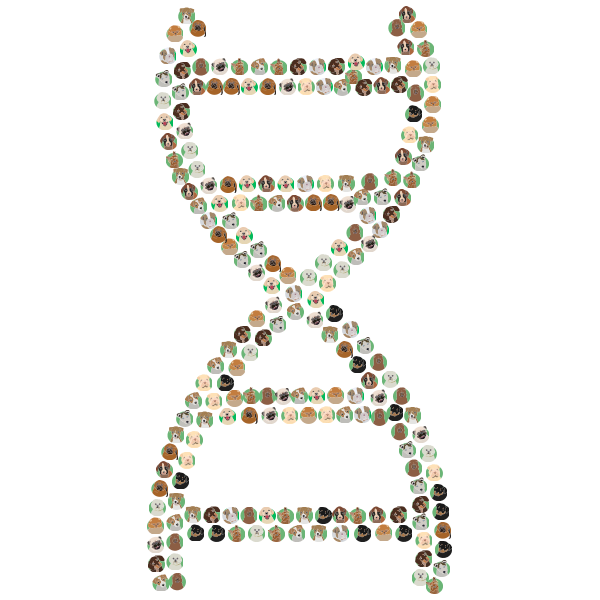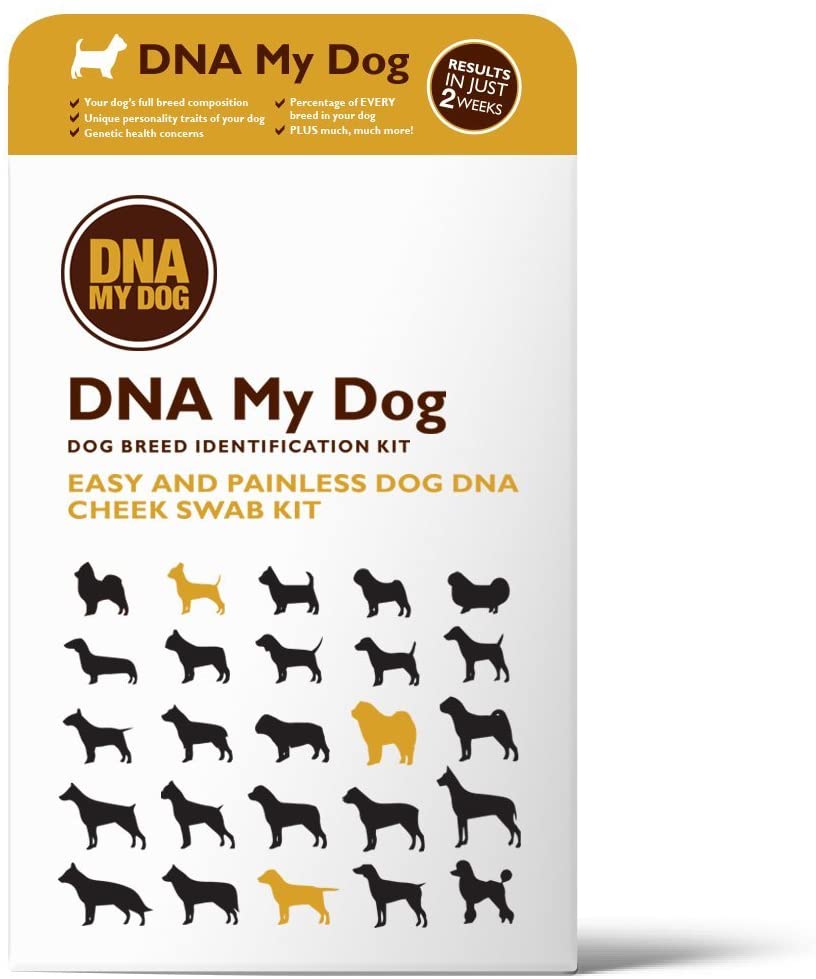Does this sound familiar: “Your dog’s adorable! What breed is that?” We hear it a fair amount, but Greyhounds aren’t common in this area. But, of course, we know she’s a Greyhound; we have an official pedigree going back to her great-great-great-great-grandparents (and it only stops there because that’s all that fits on the page). So, if you adopted your dog or have a mixed breed, you may or may not know the answer to that burning question. Are you curious? With the availability of dog DNA tests, you can find the answer!
How Dog DNA Tests Work
Dog DNA tests utilize cheek swabs. Each test varies in the style of the swab and how you package them for shipping, but most require the same process.
- Don’t let your dog eat, drink, or come into contact with another dog for two hours before the test. This prevents possible cross-contamination. If you have multiple dogs, separate them for those two hours.
- The swab needs saliva and cells on it. You go into the mouth between the cheek and teeth and rub the swab along the gums. Don’t let your dog bite the swab. Rubbing time varies between 20 seconds and 1 minute. (You know whether your dog will tolerate this or not)
- Make sure you follow up with treats, even if your dog permitted the process.
- Follow your test’s instructions for packaging the swab, then mail it off.
Once the swab arrives at the lab, technicians extract the DNA sample and enter them into a database. That’s when a computer algorithm goes to work, creating a chart of percentages showing how much of each breed went into creating your dog.
Algorithms?
I know – you pictured scientists sitting over gene sequencers a la Jurassic Park, right? Sorry to disappoint. Dog DNA processing works based on math. The computer examines each chromosome for known breed “flags.” When it sees one that matches the database, it adds it to your dog’s chart. But, of course, if your dog has a particularly rare breed, it may not appear in individual databases. In that case, the computer won’t list it (or some tests lump them into a “mixed” category).
The ancestry report generated for your dog gets presented in percentages. This means it’s a best-guess estimate. The FDA doesn’t regulate dog DNA testing, so no one monitors the accuracy of results. So you need to take your report with a grain of salt. (Fun fact: some dog DNA tests have failed to profile known purebred dogs accurately!)
Additional Dog DNA Test Benefits
Having the ability to proudly proclaim your shelter dog as a Beagle/Pomeranian mix is pretty cool. However, knowing the breeds that make up your mixed breed dog comes with other benefits.
For instance, understanding why your dog bays every time they see a rabbit in the backyard. (Got it – that’s the Beagle at work) If you know the breed’s characteristics, you can focus their training to guide them toward (or away from) specific behaviors.
Some of the companies offer to test for genetic predispositions of medical conditions. However, even if you don’t opt for those options, certain breeds are known to carry health risks.
For instance, Boxers are predisposed to dilated cardiomyopathy (DCM). Therefore, seeing Boxer on your report can prompt you to discuss screening and monitoring your dog with your vet.
That said, genes behave differently in every dog. And these tests aren’t an exact science. Just because you receive a report about a potential health concern doesn’t mean your dog’s fate is sealed. Talk to your vet. Better yet, show them the report. They’ll give you a more confident answer.
Choosing a Dog DNA Test
There are a few dog DNA tests out there, ranging in price from reasonable to expensive. However, this is a case where you DO get what you pay for. So what are the more important considerations when looking for a dog DNA test?
- Depth: How much information are you looking for? For example, do you want a basic graph of breeds, or do you want all of the bells and whistles?
- Speed of Results: No test is instantaneous, but some ARE faster than others. How patient are you? Some tests will let you check in on their progress, while others don’t.
- Accuracy: The more extensive the test’s database has to compare your dog’s sample against, the more accurate your result is likely to be.
The Best Dog DNA Tests
You can find a fair number of dog DNA tests when you hit the internet. However, when you start pulling them apart and researching them, only three stood out time and time again. If you have a purebred dog, you don’t need a dog DNA test. (I mean, you CAN if you want. Not sure the money’s worth it) But if you adopted your dog or have a mixed breed, and you want to satisfy your curiosity, then they’re an excellent investment.
Okay, so you just want to know your dog’s breed – no bells and whistles, no big price tag. DNA My Dog has an option for you. Their database has around 100 breeds. The kit contains two swabs and a return envelope (please note: postage is NOT included). Their results are available in about 1-2 weeks (the fastest turnaround time!). You then receive an adorable certificate, complete with your dog’s picture.
Rather than using percentages, DNA My Dog reports your dog’s breed in levels. For example:
- Level 1: The majority of your dog’s DNA
- Level 2: 40-75% of your dog’s DNA
- Level 5: Less than 10% of a particular breed
They also provide a rough genetic age for your dog by examining the length of your dog’s telomeres. Telomeres are the end caps of chromosomes, and they get shorter as you age. This particular feature appeals to a lot of rescues and shelters, and they often use these kits to help boost adoptions.
Downsides?
- With only 100 breeds, there’s a good chance your dog might have a breed they don’t include.
- You have to use both swabs to complete the test. If your dog isn’t patient, they might protest.
The Good
- Reasonable cost
- Fast turnaround time
The Bad
- Database only has 100 breeds
- Must pay postage
- Must use 2 swabs to complete test
Embark has a database of over 250 breeds. They also screen for 171 different genetic diseases. Embark developed the kit through a partnership with Cornell University College of Veterinary Medicine (the only dog DNA test associated with a veterinary hospital). You get a single swab in the kit, which you then place in a travel medium (also included) and a pre-paid postage envelope to return to the lab. It takes between 2-4 weeks for results to come back, but Embark is happy to send you updates on their progress the entire time.
When your results come in (available both on their website and as a downloadable report), you not only get your breed profile and health report, you get all of the following:
- Breed ancestry to the great-grandparent level
- An inbreeding score
- 25 breed trait markers
- A predicted adult weight (this may or may not be helpful if your dog is already an adult)
- A “genetic human age”
- A “wolfiness” score (how much wolf appears in your dog’s ancestry)
- A list of your dog’s relatives (assuming they’ve used Embark)
- You can even connect socially with their owners!
If your dog’s health report shows anything of concern, a geneticist will contact you in person to discuss the result. In fact, people loved Embark’s customer service, in general, and felt they were very responsive.
The Embark company sponsors the International Partnership for Dogs (IPFD). The IPFD consortium standardizes the genetic testing of dogs throughout the world. Members must publicly disclose their accreditations, mishandling protocols, licenses and patents, and genetic-testing lists as part of their sponsorship. In other words, Embark allows full transparency into their work. That’s an excellent thing.
The downsides?
- Embark IS on the expensive side. You’ll need to look at everything you’re getting and decide whether it’s worth the investment.
- While there’s just one swab, it’s pretty large (in fact, it’s the largest out there). People with small dogs (under 20 pounds) had trouble fitting it inside those little mouths.
- The kit has instructions on pretty much every single item. People felt it muddied things a bit and made it hard to follow (i.e., one set would be enough).
- There is a slight delay between the breed and health results (about 1-2 days).
- Once you get your results, prepare for a FLOOD of marketing emails. People weren’t ready for quite that volume.
The Good
- Database of over 250 breeds and screen of 171 genetic diseases
- Results available on website and on downloadable report
- Social network available for dog's relatives
The Bad
- Expensive
- Swab large, especially for small dogs
- Overload of marketing emails
If you adopted your dog outside of the United States or think there might be a rare breed hiding in their pedigree, Wisdom is the kit for you. Their database contains a whopping 350 breeds – the most of any test out there! They also test for 152 different genetic diseases. The kit includes two swabs and an envelope with pre-paid postage. You do need to let the swabs dry before sending them, but the kit’s tray has holes to support the swabs while drying. Wisdom’s response time varies between 3-4 weeks.
You receive an emailed response providing your dog’s breed results, as well as the following:
- Breed ancestry to the great-grandparent level
- Your dog’s genetic health screen
- Results are broken down into categories of “at risk,” “carrier,” and “clear”
- 7 breed trait markers
- Your dog’s ideal weight range
All of your results come in at the same time – no delay. If you have any questions, Wisdom encourages you to call. People love their customer service, too.
Like Embark, Wisdom sponsors the IPFD. They also take the additional step of researching with the DNA samples they receive. (You select whether or not you want your dog’s samples to participate)
So what are the downsides?
- Like Embark, Wisdom is expensive.
- The swabs have bristles. While this design helps obtain quality samples, it can irritate your dog’s gums.
- Unlike other test kits, Wisdom requires you to swab your dog’s gums THREE times. With those bristles promising possible irritation, don’t be surprised if your dog hightails it for the other room when they see you coming that second and third time.
- The tray comes with holes to support the swabs, but many people felt the swabs didn’t remain sturdy. You might want to use something else to hold them while they dry. (You don’t want them to fall and end up contaminated)
- Wisdom hides some “at risk” health values if they feel they’re irrelevant. They are using fewer DNA markers than Embark, to begin with, so the results aren’t as accurate, but some people were upset to learned results were excluded.
The Good
- Database contains 350 breeds and 152 genetic diseases
- Email response with both breed and disease report
- Excellent customer support
The Bad
- Expensive
- Must swab gums 3 times
- Not all health values get reported
“What Kind of Dog is That?”
Suppose you’re curious why your dog has a penchant for digging up the backyard.
Perhaps you want to know what breeds created the unique adorableness that is your dog.
Or maybe you just don’t want to label your dog a “mutt” anymore.
Dog DNA tests can provide all of those answers (and potentially more!). You never know – you might find some surprises lurking in the genetic code of your precious pooch!









No comment yet, add your voice below!